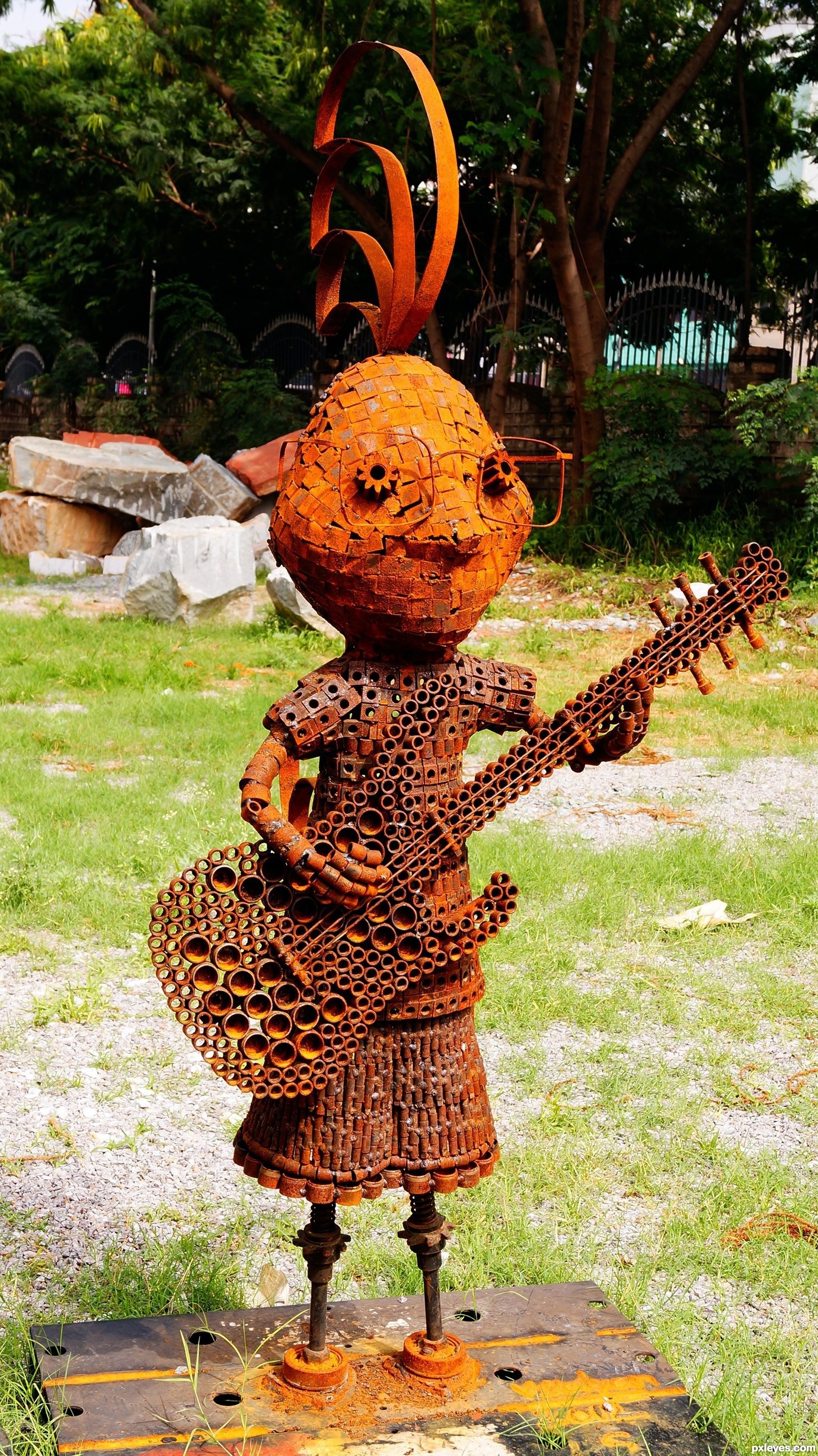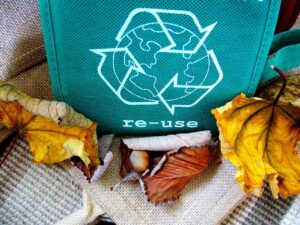Introduction: The Art of Recycling
Imagine a world where every bit of ‘rubbish’ is not merely trash destined for a landfill but a potential work of art. Picture the humble cereal box you discard each morning or the old denim jacket gathering dust in your closet. Even the bicycle tire that’s seen better days. Now, instead of viewing these items as clutter or garbage, let’s look at them through a different lens. Picture them not as discards but as the foundation of something visually stunning and deeply impactful. Sounds fascinating, doesn’t it? Well, buckle up, dear reader, because you’re about to embark on a colorful journey through the innovative, transformative world of recycled art!
Recycled art, the practice of repurposing and reimagining ‘waste’ into artwork, is like the Cinderella story of the art world. It takes what is often overlooked, discarded, and underestimated and transforms it into something beautiful and meaningful. It’s not just about making something aesthetically pleasing from rubbish; it’s about challenging our perspectives on waste, value, and creativity. So, hold on tight as we dive into this exploration of recycled art!
Understanding Recycled Art
What is Recycled Art?
In essence, recycled art, often known as junk art or found object art, involves the process of turning discarded items or “waste” materials into unique, aesthetic, and functional works of art. Think of it like a phoenix rising from the ashes but with less fire and more creativity! It’s the art of giving a second life to items that would have otherwise been lost in the landfill, thereby redefining our understanding of what constitutes ‘waste.’
Benefits of Recycled Art
There’s much more to recycled art than just unleashing your creative instincts. Firstly, it plays a significant role in reducing waste that would otherwise end up in landfills, helping us do our part in preserving the environment. Secondly, it opens a world of boundless creativity where anything from an old shoe to a rusty one can transform into a masterpiece. Moreover, it encourages us to look at the world differently, questioning our consumption habits and fostering a more sustainable lifestyle.
Furthermore, creating recycled art is a fantastic way to engage kids and adults alike in understanding sustainability and the significance of recycling while fostering creativity. Plus, who wouldn’t love to brag about their artwork made entirely from soda cans or bottle caps? Indeed, recycled art is a true conversation starter!
Exploring Types of Recycled Art
Sculpture and Installation
One of the most common forms of recycled art is sculpture and installation art. Have you ever seen a 10-foot-tall gorilla made entirely out of car parts? Or a chandelier from old bottles? The beauty of sculpture and installation art is that it turns ordinary, often overlooked items into extraordinary masterpieces. From giant animal sculptures to intricate installations that tell a story, this type of recycled art often leaves viewers in awe of the creative use of everyday objects. Remember, folks, one man’s trash truly can be another man’s (or woman’s) treasure!
Textile Art and Collage
Now let’s talk about textile art and collage. This art form uses old clothes, worn-out fabrics, newspapers, and books to create beautiful 2D or 3D artworks. If you have an old T-shirt, ripped jeans, or outdated magazines, you’re all set to start! The process can be as simple as cutting and pasting or involve more complex techniques like weaving, stitching, and layering. The result? Stunning artworks that are like Frankenstein’s monster – only less scary and more aesthetically pleasing!
Functional Art
Now, this is where things get even more interesting. Recycled art isn’t just about creating visually appealing pieces; it’s also about crafting items that serve a purpose. Welcome to the world of functional art – where creativity meets utility! From furniture made from salvaged wood to light fixtures made from bicycle parts, functional art showcases that beauty and utility can indeed co-exist. Picture a coffee table made from an old door or a lamp crafted from a vintage camera – it’s as if MacGyver got an arts and crafts kit!
Famous Recycled Art and Artists
Masterpieces of Recycled Art
Our journey through the grand tapestry of recycled art wouldn’t be complete without a look at the show-stopping pieces that have left indelible marks on this genre. Many such masterpieces have redefined the face of contemporary art and shed light on pressing issues such as waste management and sustainability.
For instance, consider WEEE Man – a gargantuan figure created by the Royal Society for the Encouragement of Arts, Manufactures, and Commerce in the UK. This behemoth, made entirely from waste electrical and electronic equipment, is a stark reminder of the growing electronic waste each person generates in their lifetime.
Then there’s the acclaimed work of Portuguese artist Bordalo II, who creates large-scale installations of animals out of trash, highlighting the devastating impacts of pollution on wildlife. His art is as provocative as it is eye-catching, provoking thought on our environmental responsibilities.
Influential Artists in Recycled Art
Now, let’s turn our attention to the trailblazers, the visionaries, and the downright creative geniuses who have pushed the boundaries of what’s possible with recycled art.
- Willie Cole: This American artist has truly embraced the idea that one man’s trash is another man’s treasure. Cole’s found-object artworks are provocative statements on consumer culture, historical memory, and identity. His sculptures, often created from everyday objects like steam irons, women’s shoes, or hair dryers, force us to reconsider these mundane items in a new light.
- Michelle Reader: Reader creates delightfully quirky figurative sculptures using a mix of reused and recycled materials. From a family portrait made entirely of their own rubbish to a commission using waste materials from the construction of Heathrow Terminal 5, Reader’s work has a storytelling quality that makes you look closer.
- Robert Bradford: You might never look at your childhood toys the same way after seeing Bradford’s work. This artist creates large-scale, whimsical sculptures using discarded toys, transforming objects of childhood innocence into compelling pieces of art.
How to Get Started with Recycled Art
Materials You’ll Need
To begin your foray into recycled art, you’ll need some materials. Look around you. See those old newspapers, that stack of cardboard, those worn-out clothes? They’re not trash; they’re art supplies. Besides these recycled materials, you might also need some crafting tools, such as scissors, glue, and perhaps some paints.
Detailed Steps to Creating Your First Recycled Art Project
Let’s delve deeper into the process of creating your first recycled art project.
- Identify Your Materials: Begin by scavenging through your home for discarded items. You’d be surprised at what might come in handy! Be it broken toys, old buttons, or even plastic bags – all of these could be potential gold mines for your artwork.
- Seek Inspiration: The next step involves stoking your creative fires. Browse the internet, visit local art exhibitions, or study the work of recycled art masters. Inspiration can strike from the most unexpected places.
- Conceptualize Your Art: Now, it’s time to conceptualize your masterpiece. Sketch or note down your ideas. This gives you a clear picture of what you want to create and helps you identify any additional materials you might need.
- Create Your Masterpiece: This is the fun part! Start assembling your materials to create your art. Don’t worry if things don’t go exactly as planned – after all, the beauty of art lies in its imperfections. Remember to take your time and enjoy the process.
- Display Your Art: Once you’re satisfied with your creation, find a spot to display it. Whether in your living room, on your office desk, or even in your garden – your art deserves to be seen.
- Share Your Journey: The world needs more artists, and by sharing your journey, you could inspire others to explore recycled art. So, share your process, your triumphs, and your challenges.
Creating recycled art can be an exciting journey that not only cultivates creativity but also helps protect our planet. So, go on, don your artist’s hat, and dive into the fascinating world of recycled art!
Conclusion: The Potential of Recycled Art
When we create or appreciate recycled art, we’re not just celebrating the artist’s talent and creativity. We’re also acknowledging their vision and their ability to see potential where others see waste. This vision, this ability to think outside the box (or the recycling bin, in this case), is more critical today than ever before. As we grapple with climate change, environmental degradation, and the mounting waste crisis, recycled art provides a beacon of hope and possibility.
So, the next time you’re about to toss something into the trash, take a pause. Look at it again. Is it truly a waste, or could it be something more? Could it be art? Whether it’s a tiny paper crane made from a magazine page or a massive sculpture made from discarded car parts, every piece of recycled art carries a powerful message—one of transformation, sustainability, and of endless human creativity. And who knows, maybe the next masterpiece could be yours!
Embrace the spirit of recycled art. Unleash your creativity. Transform the discarded into the extraordinary. Remember, in the world of recycled art, nothing is ever truly wasted, and the possibilities are as limitless as your imagination.
FAQs
- What can I make with recycled materials? The possibilities are endless! You can create everything from jewelry, sculptures, and home decor to practical items like furniture.
- Do I need any special tools or skills to create recycled art? Not necessarily. While certain projects might require specific tools, most recycled art can be created with common household items.
- Where can I display my recycled art? You can display your art anywhere you’d like – your living room, office, or even a local art exhibition.
- Are there any safety considerations when creating recycled art? Yes, always ensure you’re working in a safe environment. Use protective gear when necessary and ensure your materials are clean and safe.
- Can I make money from recycled art? Absolutely! Many artists sell their recycled art pieces online, at art fairs, or through galleries. So, your hobby could well turn into a profitable venture!




